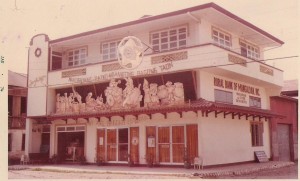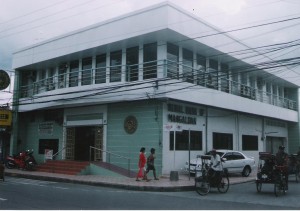Unknown to many, the town name “Mangaldan” has different stories of origin. However, according to a Dominican Priest Fr. Raymundo Suarez, OP, in his manuscript, “Apuntes Cureosos de Pangasinan,” the word “Mangaldan” was derived from the root word “Alar” or “Alad,” which means a fence made of bamboo or of any similar material. Despite the presence of bamboo fences all over the town, Mangaldan’s primary economic resources include farming, livestock, poultry and fish. Its inhabitants, approximately 92,000, were known to be peace loving, intelligent and generous people.
 |
 |
The Evolution of Rural Bank of Mangaldan: The original old building of the rural bank in 1963 (Left) and the Rural Bank of Mangaldan at present (Right).
It is in this first-class soil did the Rural Bank of Mangaldan laid its foundation. It was through the initiative of Drs. Ricardo C. Villamil and Vicente Jimenez that this bank was born. Reluctant to pursue banking due to lack of experience and background, Dr. Jimenez was later on convinced by Dr. Villamil to start to what will later become an outstanding financial institution of Mangaldan and nearby towns.
Rural Bank of Mangaldan prioritize their clients by offering a variety of deposit and lending services to meet the demands of the community. Among which are savings, time certificate of deposits and demand deposits. For lending, they offer agricultural loans, agrarian reform loans, commercial loans, industrial loans, short, medium and long-term loans, micro finance loans and money shop loans.
Apart from delivering the usual banking services, the Rural Bank of Mangaldan has never neglected its corporate social responsibility. Believing that education is the key to escape from the clutches of poverty, the bank sends poor but deserving students to pursue their studies. The bank also has programs geared towards environmental protection by engaging students from Talogtog Elementary School and Gueguesangen Elementary School in tree-planting activities.
Due to its outstanding contribution in the development of the countryside by being responsive to the needs of the rural community, Rural Bank of Mangaldan received numerous awards during the years 1970 to 1987.
Among which are as follows:
Golden Plaque Award as “Rural Bank of the Year 1976.” Which was presented to Dr. Jimenez by then box office movie queen Alma Moreno, assisted by Modesto Francisco, special assistant to the Central Bank Governor, and Manuel Santos of the CB-DRBSLA, and witnessed by then Secretary Arturo Tangco of the Department of Agriculture;
Achievement Award as “Most Outstanding Rural Bank of the Country for 1976-1977,” from the Central Bank of the Philippines;
“Rural Bank of the Year 1976-77, from the Samahang Bangko Rural ng Pangasinan”
“One of the Ten Best Managed Rural Banks in Region I in 1983,” from the Central Bank of the Philippines;
Rural Bank of Mangaldan prides itself as the No. 1 single taxpayer in Mangaldan and for taxable year 2001, the No. 1 taxpayer in Pangasinan.
Since stability came hand-in-hand with the quality of leadership, Dr. Vicente Jimenez has turned over the stewardship of the bank to his son, Mr. Alberto Jimenez, who is presently serving as the Chairman of the Board, President and General Manager. Like his father and predecessor, the latter is equally competent in continuing the legacy of the founder. He had been the President of the Samahang Banko Rural ng Pangasinan Foundation, Inc. in 2001-2003 and President of the Confederation of Northern Luzon Rural Banks in 2002-2003.
As the bank celebrates its golden anniversary of service, advocacy and quality, clients can rely on the touchstones the bank have since its humble beginning to prove that rural banking remains the finest partner in the countryside in times of need. The bank holds itself as a fine example of stewardship, which can be attested by its 50 years of uplifting the lives of the people of Mangaldan.
Over the years of brilliance in the industry, the Rural Bank of Mangaldan now known as the Bangko Rural ng Mangaldan was able to set a standard in the industry not only in the town but also in nearby areas and will continue to do so in the years ahead as led by its new management.

